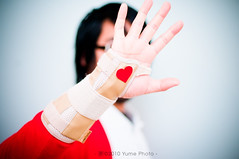
There are estimates floating around the Internet that up to 80% of people diagnosed with fibromyalgia have sleep apnea.
My Sleep Apnea Story
About a year and a half into my workup and treatment for fibromyalgia, I was sent for a sleep study. I actually had to spend two nights in the sleep lab, on two separate occasions, because I only slept two hours the first night, which was not long enough to complete the split night protocol of sleep without, then with, a CPAP machine and mask.
After two night of being monitored and a grand total of about 6 hours of sleep between the two sessions, I came away diagnosed with sleep apnea and other sleep disorders. (And by the way, I really don't snore that much and my sleep studies confirmed this.)
Getting Used to CPAP Therapy
I've talked before about living with sleep apnea in my posts
The Elephant in My Bedroom and
My Routine: Trying to Get a Good Night's Sleep. Needless to say, it takes a great deal of effort on my part to make sleep apnea therapy using a CPAP machine and mask comfortable and manageable. As I mentioned before, I use a
whole host of tricks and tips to increase my compliance with nightly therapy.
For the most part, I can be compliant with therapy, but it's not always easy...
Rainout in My Hose and Mask
Today I want to talk about
rainout, a complication of using a CPAP machine, especially in colder weather.
I have a CPAP machine with a heated humidifier. The heated humidifier increases the humidity of the air being sucked into the machine and delivered to my nose via a 6 foot tube and a mask. Without the humidifier, my nose gets really dry, irritated, stuffy and swollen on the inside. Contrary to the name, a heated humidifier doesn't make the air coming through the machine any warmer; the humidifier chamber heats distilled water inside it to release water molecules into the air.
When the air in the bedroom gets colder, like in the winter, the cold room air cause the water vapor in the air leaving the machine to condense along the tubing and mask. The result: I wake up several times a night with a puddle in my mask and water droplets up my nose. Nothing is quite as shocking and disruptive to my sleep as breathing in water!
So when a cold snap hit Southern California a few weeks ago, I had no choice but to turn my heated humidifier off. That resulted in no rainout, but lots of nasal discomfort. Unhappy with this fix, I started with an Internet search for a solution that could help with rainout.
A New Machine Solves the Problem
So it turns out that CPAP technology is evolving and now there is a
machine with an integrated heated hose that virtually eliminates this problem.
The bad news for me is that my health insurance won't pay for a new and improved CPAP machine until May 2013 (that is every five years.) You see, health insurance won't pay for CPAP machine rentals. Once they pay out the equivalent of the purchase price, I own the machine. I guess it saves them money on their end, but it really doesn't help me take advantage of technology advances and machines with better compliance features.
A Universal Heated Hose
My search lead me to SleepZone in Australia, the country that is home to the inventor of the PAP machine, a precursor to the CPAP. SleepZone sells a
universal heated hose that can work with my machine. Only problem is that this medical device is not FDA approved and not available for sale in the USA. (Which made me wonder, since they didn't get it FDA approved, did that open the door for American CPAP manufacturers to steal the idea and include it into newer generation machines?)
I could buy it from SleepZone in Australia, but would need to save up about $140 to do so. And since hoses don't last forever, I would need to find $280 a year in our budget to pay for this hose solution.
CPAP MacGyvering
Next I called my CPAP supply company and told them about my problem. They offered to sell me a
CPAP hose cover, which I already have. Then they suggested I place an old fashioned hot water bottle, filled with hot water, in front of the CPAP air intake opening to try and heat up the incoming air. They also suggested I take my hose off the
hose caddy and place as much of it as I could under the bed covers with me to keep it warm.
I tried their suggestions and they seem to work, but it's not a perfect solution. It appears I've gotten rid of rainout in colder weather, but replaced it with anxiety about rolling over onto my hose in bed, damaging it or cutting off my air supply and suffocating myself, then either waking up gasping for air or pulling my mask off in my sleep.
A Better Way?
All this research and problem-solving has me asking, '
Isn't there a way insurance can work with me to make my CPAP therapy more comfortable and easy to use? Why can't I rent a machine and swap it out when a better, more patient-friendly one becomes available?'
I know that a lot of people have problems getting used to CPAP therapy. I have heard stories of people giving up when faced with how uncomfortable it can be. I make a huge effort to try and stick with it and I am proud to say that I am about 99% compliant.
That said, I resent that my insurance company limits their assistance in helping me achieve comfortable CPAP therapy. After all, if I am compliant, I am saving them money on health care for sleep apnea complications like:
- high blood pressure
- heart failure
- coronary artery disease
- stroke
- sleep deprivation and fatigue, which increase the risk of accidents
In the meantime, I'm really going to try and save up the money to purchase the SleepZone universal heated hose. After all, this solution is cheaper than buying a new machine out-of-pocket.
 Image by kurichan* via FlickrSo I am having surgery on Wednesday, this Wednesday, August 31st. And I'd be lying if I didn't say that the thought of having surgery is freaking me out.
Image by kurichan* via FlickrSo I am having surgery on Wednesday, this Wednesday, August 31st. And I'd be lying if I didn't say that the thought of having surgery is freaking me out.












![Reblog this post [with Zemanta]](http://img.zemanta.com/reblog_b.png?x-id=0a546773-bee5-46c0-8315-6a4e057cf66b)





![Reblog this post [with Zemanta]](http://img.zemanta.com/reblog_b.png?x-id=46af4328-ca3b-4131-883a-f0178c900724)